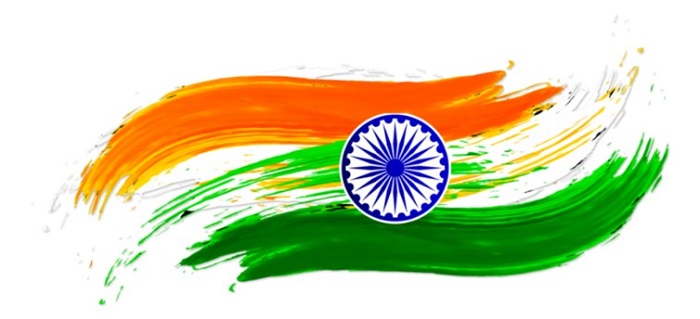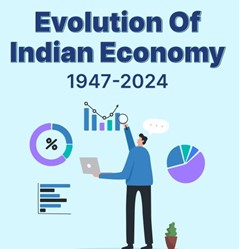The Indian economy, one of the fastest-growing in the world, has undergone significant evolution since independence. The journey of the Indian economy from tatters to an economic powerhouse has not been easy. Year on year, citizens’ and government’s Relentless and consistent efforts have built today’s India. As Dr. Manmohan Singh said, “The brightest jewel of the British crown” reclaimed its glory by becoming the fifth largest economy in the world.
In this blog, we will talk about India’s economic growth from 1947 to 2024. Since the Indian economy has a long history of 77 years, it is essential to know a brief history of the Indian economy. Therefore, for the convenience of readers, we have segregated it into parts:
7 Major Highlights Of The Indian Economy (1947-2024)
Re-Building An Economy – 1947
To understand the Indian economy’s situation in 1947 (pre-independence), we will first look at its position before independence. In 1700, India contributed 22.6% of the world economy, which was reduced to only 3.8% by 19521. After Independence, the Indian treasury was exhausted, and the ministry had to start fresh. R.K. Shanmukham Chetty, the country’s first finance minister, began to focus on import substitution industrialisation and setting up government-run public sectors.
Since no large private sectors existed, the agenda was to employ as much labour via government sectors as possible. They also started to pay close heed to heavy industries. By 1969, 14 banks were nationalised in India, and the GDP had risen to INR 5,844.8 crores.
- The Green Farming Revolution – 1965
After independence, the Green Revolution played a vital role in India’s agricultural growth and economic development.
It is a common fact that India’s primary mass is associated with agriculture, but in 1965, under the leadership of Lal Bahadur Shastri, agriculture in India became industrialised. HYV, or a high-yielding variety of seeds, was provided, along with an enhancement of agricultural tools such as the usage of tractors, good-quality pesticides, fertilizers, modern irrigation methods, etc. M.S Swaminathan supervised the policy’s working.
This saw a whopping 70% increase in farmers’ incomes and benefited agricultural sectors, mainly in Punjab, Haryana, and Uttar Pradesh. However, the policy was marred with controversy in its later stages.
- The Rise of the Private Sector – 1980
By the mid-1980s, the government was trying to devise measures to increase employment rates in the country. India was soon becoming a nation with a growing population, but the employment rates were not keeping up. This created a big challenge for the growth of India after independence. The government’s attitude towards the private sector finally began to change, and they started to liberalise certain restrictions.
Slowly, the country’s economy started to grow. From 1980 to 2002, it grew 6% annually, making it one of the best-performing economies for over two decades2. At the same time, to curb the yearly population growth of 2.2%, the government started campaigns like “Hum do humare do.” However, it was met with certain criticism.
This marks the end of the pre-liberalisation period. Let us now read about the post-liberalisation period.
- The Economic Liberalisation (LPG)- 1991
LPG (Liberalisation, Privatisation, Globalisation) did not just kick off as a grand idea of the government. In 1990, Chandra Shekhar Singh was sworn in as the Prime Minister. At that time, India was reeling in fiscal deficit due to poor economic policies. The reservoirs were empty, and the IMF and World Bank stopped their assistance.
The government used its gold reserves as collateral security with no other option. It airlifted 47 tonnes of gold to the Bank of England and 20 tonnes to the Union Bank of Switzerland. Finally, the Chandra Shekhar government collapsed, and P.V. Narasimha Rao was sworn in as Prime Minister. He roped in Dr. Manmohan Singh as his Finance Minister, which changed the course of the Indian economy.
The LPG policy opened India’s doors to foreign investors and abolished the ‘License Raj.’ Tariffs and interest rates were reduced, and the public monopoly eventually ended. From the global perspective, it was a perfect opportunity as India had a growing youth population, a good section of the population was fluent in English, and India promised considerably cheap labour. Investments started to pour in. The maximum number of companies set shop in Bangalore under the governorship of S.M. Krishna, and it soon became known as the Silicon Valley of India.
- The Great Recession – 2008
The LPG garnered tremendous success, and the Indian economy started proliferating—until 2008 when things went down south. Although India did not face the major brunt, it was a wake-up call. The IT industry, a golden ray in India’s growing structure, laid off nearly 5 lakh employees. Also, the automobile sector cut its employment by 4.79%, the textile industry by 1.29%, and the jewellery industry by 11.9%.
It made the government realise that India depended heavily on foreign investment, and they would have to start setting the base for more domestic firms.
- Demonetisation – 2016
Demonetisation shocked the citizens and an even bigger shock to the economy. It slowed down many sectors, mainly because most of India is cash-heavy. As the line in front of banks and ATMs increased, the economy went through a short-term paralysis.
The demonetisation policy had two major aims:
- To curb the circulation of black money;
- To make India a digital and cashless economy
In the beginning, demonetisation was praised because it aimed at ‘cleansing’ the economy. Eventually, an RBI report stated that 99% of the money was returned to them, which means the money had legally become white. It was also highlighted that most people who possessed black money did not tangibly own it.
- The Pandemic – 2020, 2021, & 2022
The latest inclusion to a very interesting economic history is the COVID-19 pandemic. What started as the flu that would not last for more than a few weeks extended its paws over a year. As the nation grappled with the lockdown, the second and third waves of the virus only worsened the situation. It tested the patience and capacity of the economies in no way one could imagine.
Almost 400 million people lost their jobs in 2020. Many industries, such as travel and tourism, hospitality, transport, textile, etc., faced setbacks. From an economic perspective, the pandemic washed the growth charts for India and the world. But the comeback is always greater than the setback and with the onset of 2022, the vaccination brought in a hopeful zeal among the people and the business to revamp.
With that, we conclude our list of some of the most important economic highlights from 1947 to 2024. We hope this refreshes your memory of certain crucial events that have shaped the country we call home. Explore Grip Invest and stay updated on all relevant and best investment opportunities. /// nCa, 15 August 2024 (cross post from GRIPinvest)

